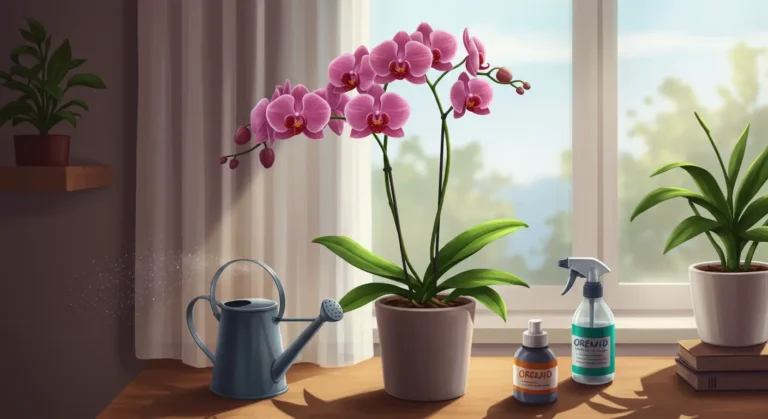Introduction
Orchids are stunning and exotic flowers that can brighten any home, but many struggle to keep them healthy. If you’re wondering how to keep orchids alive, this guide will walk you through the essential care steps. Whether a beginner or an experienced gardener, these expert tips will ensure your orchids thrive for years.
Understanding Orchid Care Basics
Orchids require a specific balance of light, water, temperature, and humidity to grow successfully. Unlike other houseplants, orchids have unique needs that, when met, will help them flourish. Learning how to keep an orchid plant alive starts with understanding these fundamentals.
Choosing the Right Orchid for Your Home
Some orchids are easier to care for than others. If you’re new to orchid care, consider starting with these beginner-friendly varieties:
- Phalaenopsis (Moth Orchid) – The easiest to maintain, requiring moderate light and watering.
- Dendrobium – A resilient species with beautiful flowers.
- Cattleya – Known for its vibrant blooms and easy-growing nature.
Selecting the right orchid is key to mastering orchids care and ensuring long-term success.
How to Keep Orchids Alive: Light, Water, and Temperature Needs
Light Requirements
- Orchids need indirect bright light for healthy growth.
- Avoid direct sunlight, which can scorch leaves.
- East or south-facing windows are ideal spots.
Watering Techniques
- Water your orchid once a week, but avoid overwatering.
- Use room-temperature water and ensure proper drainage.
- Misting can help maintain humidity levels.
Temperature & Humidity
- Orchids thrive in 65-75°F (18-24°C) temperatures.
- Maintain humidity levels of 40-60% for best results.
- Use a humidity tray or room humidifier if needed.
How to Keep an Orchid Plant Alive: The Best Potting Mix and Containers
Choosing the right potting mix and container ensures proper air circulation and moisture retention:
- Potting Mix: Use a specialized orchid bark mix instead of regular soil.
- Containers: Select pots with drainage holes to prevent root rot.
- Repotting: Repot every 1-2 years to refresh the growing medium.
Orchids Care: Common Mistakes to Avoid
Many orchid owners make these common mistakes, leading to poor growth:
- Overwatering: Causes root rot and weak plants.
- Placing in direct sunlight Can burn leaves and hinder flowering.
- Using regular soil: Orchids need well-draining bark or sphagnum moss.
- Ignoring humidity levels: Dry air can cause buds to drop prematurely.
Avoiding these mistakes is crucial for mastering how to keep an orchid alive successfully.
How to Keep an Orchid Alive During Blooming and Dormancy
Orchids have bloom cycles, and proper care during each phase ensures continuous flowering:
- Blooming Phase:
- Keep the temperature stable and continue regular watering.
- Apply a balanced orchid fertilizer every 2-4 weeks.
- Dormancy Phase:
- Reduce watering slightly, but do not let roots dry out.
- Keep the plant in a well-lit area to encourage new growth.
Understanding these cycles is key to how to keep orchids alive for years.
Best Fertilizers and Nutrients for Orchid Growth
Using the right fertilizer boosts orchid health and encourages blooming:
- Use a balanced orchid fertilizer (20-20-20) diluted to half strength.
- Apply every 2 weeks during active growth.
- Reduce feeding during dormancy but never completely stop.
Proper feeding is vital to orchid care and ensures healthy flowers and foliage.
Troubleshooting Common Orchid Problems
If your orchid is struggling, here are solutions to common issues:
- Yellow Leaves: Usually caused by overwatering or too much direct light.
- Drooping Buds: Lack of humidity or temperature fluctuations.
- No Blooms: Insufficient light or improper fertilization.
- Pests (Aphids, Mealybugs): Wipe leaves with neem oil or insecticidal soap.
Knowing how to troubleshoot problems is essential for successfully keeping an orchid plant alive.
FAQs
Q1: How often should I water my orchid?
A: Water once weekly, ensuring proper drainage to prevent root rot.
Q2: Can I keep my orchid in direct sunlight?
A:No, orchids thrive in indirect bright light. Direct sun can scorch leaves.
Q3: Why are my orchid’s leaves turning yellow?
A: This is usually due to overwatering or too much sunlight.
Q4: How do I get my orchid to bloom again?
A: Provide proper light, temperature, and fertilization to encourage reblooming.
By following these expert care tips, you can master how to keep orchids alive and enjoy their beautiful blooms year after year. Whether you’re learning to keep an orchid plant alive or looking for orchid care tips, consistency, and proper maintenance are key. With the right approach, anyone can succeed in how to keep an orchid alive effortlessly.

